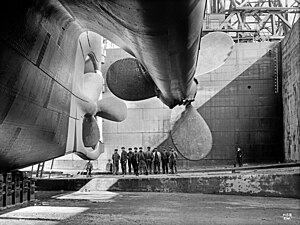User:Bearmoose/sandbox
Construction
[edit]Harland and Wolff shipyard
[edit]Titanic was a White Star Line ocean liner built at the Harland and Wolff shipyard in Belfast and was designed to compete with rival company Cunard Line's Lusitania and Mauretania, known for being the fastest liners on the Atlantic. Titanic, along with its Olympic class sisters, Olympic and the soon-to-be-built Britannic (originally to be named Gigantic [1]), were intended to be the largest, most luxurious ships ever to operate. Titanic was designed by Harland and Wolff chairman Lord Pirrie, head of Harland and Wolff's design department Thomas Andrews and general manager Alexander Carlisle, with the plans regularly sent to White Star Line's managing director J. Bruce Ismay for suggestions and approval. Construction of Titanic, funded by the American J.P. Morgan and his International Mercantile Marine Co., began on March 31 1909. Titanic No. 401, was launched two years and two months later on May 31 1911. Titanic's outfitting was completed on March 31 the following year.
Titanic was 882 ft 9 in (269 m) long and 92 ft 6 in (28 m) at its beam, it had a Gross Register Tonnage of 46,328 tons, and a height from the water line to the boat deck of 60 ft (18 m). It contained two reciprocating four-cylinder, triple-expansion, inverted steam engines and one low-pressure Parsons turbine which powered three propellers. There were 25 double-ended and 4 single-ended Scotch-type boilers fired by 159 coal burning furnaces that made possible a top speed of 23 knots (43 km/h). Only three of the four 63 foot (19 m) tall funnels were functional; the fourth funnel, which only served as a vent, was added to make the ship look more impressive. The ship could hold a total of 3,547 passengers and crew and, because it carried mail, its name was given the prefix RMS (Royal Mail Steamer) as well as SS (Steam Ship).
Titanic was considered a pinnacle of naval architecture and technological achievement. It was thought by The Shipbuilder magazine to be "practically unsinkable". Titanic was divided into 16 compartments with doors that were held by a magnetic latch and would fall by moving a switch on the bridge; however, the watertight bulkheads did not reach the entire height of the decks (only going as far as E-Deck). Titanic could stay afloat with any two of its compartments flooded, eleven of fourteen possible combinations of three compartments flooding or the first/last four compartments flooded; any more and the ship would sink.
Unsurpassed luxury
[edit]
For its time, the ship was unsurpassed in its luxury and opulence. The ship offered an onboard swimming pool, gymnasium, a Turkish bath, library and squash court. First-class common rooms were ornately decorated with elaborate wood paneling, expensive furniture and other elegant decorations. In addition, Café Parisienne offered superb cuisine for the first-class passengers with a delightful sunlit veranda fitted with trellis decorations.
Second-class and even third-class accommodation and common rooms were likewise considered as opulent as first-class on many other ships of the day. The ship offered three lifts for use of first-class passengers and, as an innovation, offered one lift for second-class passengers.
The crown jewel of the ship's interiors was undoubtedly its forward first-class grand staircase, between the forward and second funnels. Extending down to E-Deck and decorated with oak paneling and gilded balustrades, it was topped by an ornate wrought-iron and glass dome which brought in natural light. On the uppermost landing was a large panel containing a clock flanked by the allegorical figures of Honour and Glory crowning Time. A similar, less ornate staircase, complete with matching dome, was located between the third and fourth funnels.
Comparisons to the Olympic
[edit]Titanic was nearly identical to its older sister, Olympic, but there were a few differences between the ships. Some of them were suggested by Bruce Ismay, based on observations he had made of Olympic. The most noticeable differences were that half of Titanic's forward promenade A-Deck (below the lifeboat deck) was enclosed, while its B-Deck configuration was completely different from that found on Olympic. Titanic was fitted with a specialty restaurant called Café Parisienne, a feature that Olympic wouldn't be provided with until 1913. Some of the flaws found on Olympic, such as the creaking of the aft expansion joint, were corrected on Titanic. Other differences such as Titanic's skid lights, that provide natural illumination on A-deck, were round while on Olympic they were oval. Titanic's wheelhouse was modified to be narrower and longer than Olympic's. [1] These and other modifications made Titanic 1,004 tonnes larger than Olympic.
- ^ The Britannic was originally to be named Gigantic: its proposed name was changed to reduce any perception of hubris after Titanic sank. Bonner, Kit & Bonner, Carolyn (2003). Great Ship Disasters, pp.60. MBI Publishing Company. ISBN 0-7603-1336-9.
{{cite book}}: CS1 maint: multiple names: authors list (link) Read this book on Google Print
